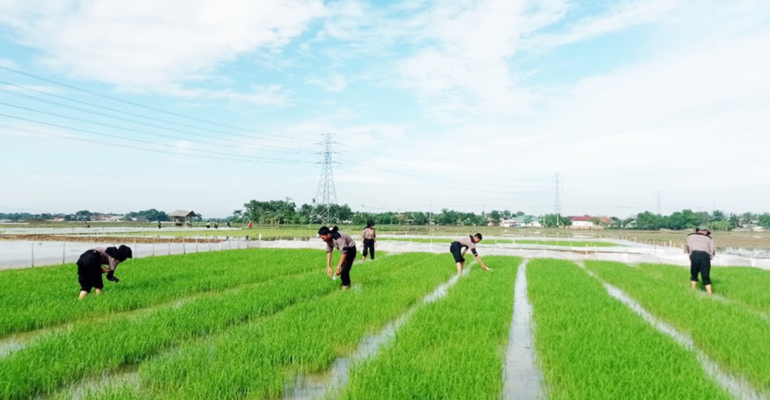IPB University Expert: Bioimmunisation Technology and Rice Pest Egg Collection Tested Effective on 500 Ha of Rice Fields in Subang

Pest and disease control is an important component in maintaining crop productivity. IPB University has a success story in implementing pest and disease control on a large scale in Subang, West Java. A new approach applied by IPB University has been tested effective on 500 hectares of rice fields in the third national rice barn district.
The new approach is called Integrated Pest and Disease Management-Biointensive (IPM-Biointensive). This technology has been applied in two locations in Subang, firstly in IPB Subang Innovation Village – Kiarasari Village, Compreng covering 350 hectares (ha). The second location is in the Patriot Pangan programme area in Ciasem Girang Village, Ciasem covering 100 ha.
IPB Subang Innovation Village in Kiarasari, Compreng in the first planting season (MT) this year produced 9.72 tonnes of harvested dry grain per hectare (GKP/ha). Meanwhile in Ciasem, the harvest on the Patriot Pangan programme land in Ciasem Girang Village, produced 10 tonnes of GKP/ha. In both places, productivity exceeded the average of 7.3 tonnes per ha.
More about the IPM-Biointensive technology, Prof Suryo Wiyono, Professor of Plant Protection at IPB University explained, “The main components consist of bioimmunising plants with endophytic fungi and tested bacteria, as well as creating many pest predators with organic fertilisers and avoiding the use of pesticides until 35 days of age.”
In addition, monitoring of borer flights with light traps is also carried out, followed by the collection of egg clusters. In its implementation, the monitoring involved teachers and students of SMKN Compreng. Activities carried out include monitoring rice stem borers, collecting egg clusters in the nursery, and bioimmunising plants with microbes.
“The results of the application of this technique can be directly seen and felt by farmers. Stem borer infestation in the Compreng area is no higher than 1 per cent until the harvest season arrives. Meanwhile, stem borer attack in the neighbouring village reached 11.0 per cent,” said Prof Suryo, who is also the Dean of the Faculty of Agriculture at IPB University.
Similar to Compreng, in Ciasem, especially the Ciasem Baru area, which is an endemic area for stem borers, the level of borer attack in the application plots was only 21.59 per cent. This is much lower than those using conventional methods, which reached 67.3 per cent.
Dr Dewi Sartiami, a pest expert at IPB University, said that light trap monitoring has proven effective in managing stem borers. This method can see the peak flight of borer moths and determine the timing of collecting egg clusters.
One of the Kiarasari farmers, Maman (50 years old), admitted that with this bioimmunisation, germination is better. “In fact, because there are more seedlings growing, I have surplus seedlings, and many of them are donated to friends in need,” he said.
“By using this technology, we farmers save a lot of money because we only use pesticides once, whereas usually we can spray up to ten times,” added Maman.
“This technology is great, but unfortunately many people don’t know about it. So, this technology must be disseminated so that more farmers know about it,” explained Vektor (42), a farmer from Ciasem Girang, who is also a programme participant.
“The bio-immunisation technology has a good effect on the growth of rice plants, starting from the nursery where the germination rate is almost 100 per cent. Seedling growth is also evenly distributed, with roots growing thicker,” he continued.
With its reliability and low cost, Prof Suryo Wiyono believes that this technology is ready to be applied on a larger scale. (*/Rz) (IAAS/RUM)


